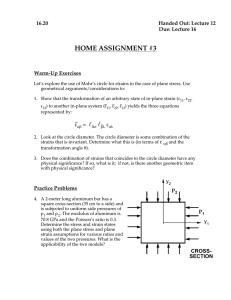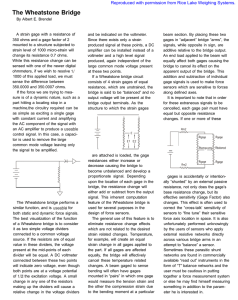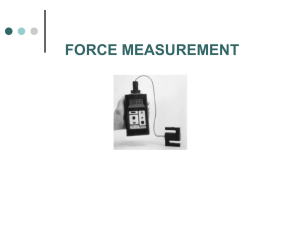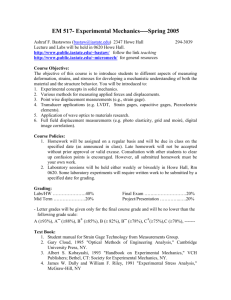Resistance Strain Gage Circuits
advertisement
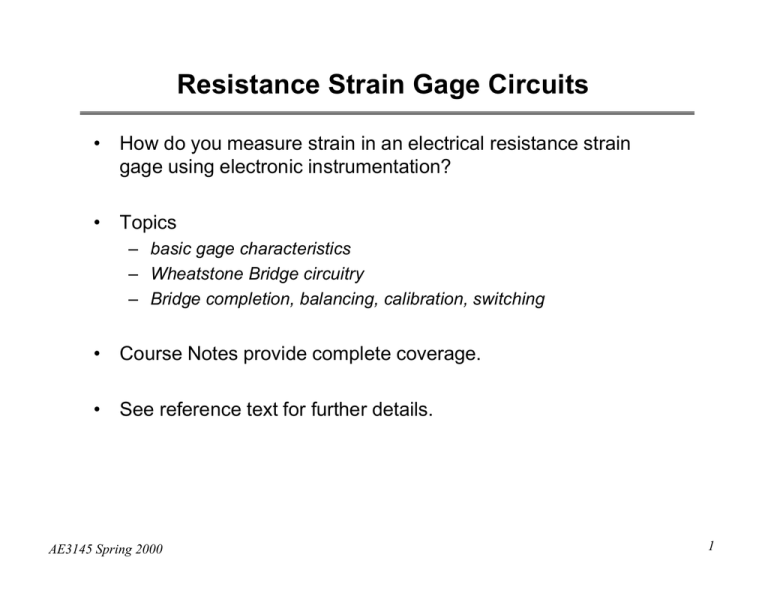
Resistance Strain Gage Circuits • How do you measure strain in an electrical resistance strain gage using electronic instrumentation? • Topics – basic gage characteristics – Wheatstone Bridge circuitry – Bridge completion, balancing, calibration, switching • Course Notes provide complete coverage. • See reference text for further details. AE3145 Spring 2000 1 Resistance in Metallic Conductor Resistance Equation: Change in R: L A ∆R = ρ L L + ∆L − ( ρ + ∆ρ ) A A + ∆A ∆L L Wire before and after strain is applied 4 R=ρ 10% rhodium/ platinum 3 % ∆R/R Differential change in R: æ Lö ∆R ≅ dR = d ç ρ è A or: dR dρ dL dA = + − R ρ L A After a bit of manipulation: dR dρ = + (1 + 2υ ) ε R ρ Ferry alloy 2 Constantan alloy 1 DEFINE Gage Factor (GF): GAGE FACTOR = GF = dR / R ε 40% gold/palladium GF is the slope of these curves Nickel 0 2 1 3 % Strain AE3145 Spring 2000 2 Examples Table 1. Gage Factors for Various Grid Materials Material Copper Constantan* Nickel Platinum Silver 40% gold/palladium Semiconductor** Gage Factor (GF) Low Strain High Strain 2.6 2.2 2.1 1.9 -12 2.7 6.1 2.4 2.9 2.4 0.9 1.9 ~100 ~600 Ultimate Elongation (%) 0.5 1.0 -0.4 0.8 0.8 -- * similar to “Ferry” and “Advance” and “Copel” alloys. ** semiconductor gage factors depend highly on the level and kind of doping used. Example 1 Assume a gage with GF = 2.0 and resistance 120 Ohms. It is subjected to a strain of 5 microstrain (equivalent to about 50 psi in aluminum). Then ∆R = GF ε R = 2(5e − 6)(120) = 0.0012 Ohms = 0.001% change! Example 2 Now assume the same gage is subjected to 5000 microstrain or about 50,000 psi in aluminum: ∆R = GF ε R = 2(5000e − 6)(120) = 1.2 Ohms = 1% change AE3145 Spring 2000 3 Resistance Measuring Circuits Ballast Circuit Current Injection ballast Constant Current Source i R e Rb E Rg e Output: Impractical resolution problems e= Rg Rg + Rb Small changes: é dRg Rg dRg ù de = ê E − 2 êë Rg + Rb Rg + Rb ) Rb Rg E dRg = (Rb + Rg )2 Rg ( = Rb Rg E (R b Output Output includes includes E/2 E/2 plus plus an an incremental, incremental, de, de, which which is VERY small! is VERY small! + Rg ) 2 ) GF ε Optimal output (Rb=Rg): de = GF ε E 4 e+de=E/2 + GF/4 ε E AE3145 Spring 2000 4 Wheatstone Bridge Circuit R1 R2 R1 e R2 e R4 R3 R4 DC R3 DC Wheatstone Bridge Back-to-back Ballast Circuits Output: é R2 R3 ù R2 R4 − R1 R3 e=ê − E= E ( R1 + R2 )( R3 + R4 ) ë R1 + R2 R3 + R4 Balance Condition: R2 R4 = R1 R3 AE3145 Spring 2000 5 Linearized Bridge Equations 0.2 Differential ouput: 0 e/E é R1 R2 æ dR1 dR2 ö R3 R4 æ dR3 dR4 öù ç ÷÷ + ç ÷ E − − de = ê 2 ç R2 ø ( R3 + R4 ) 2 çè R3 R4 ÷ø ë ( R1 + R2 ) è R1 -0.2 Assuming initially balanced bridge: é dR dR dR dR ù de = 14 ê 1 − 2 + 3 − 4 E R2 R3 R4 ë R1 -0.4 Linearized result -1 -0.5 0 0.5 1 ∆R/ R Nonlinear effects Using definition of GF and e+de=de: e= • GF [ε1 − ε 2 + ε 3 − ε 4 ]E 4 • • • AE3145 Spring 2000 The equation identifies the first order (differential) effects only, and so this is the “linearized” form. It is valid only for small (infinitesimal) resistance changes. Large resistance changes produce nonlinear effects and these are shown in Figure 3 where finite changes in R (∆R) in a single arm are considered for an initially balanced bridge. Output is directly proportional to the excitation voltage and to the Gage Factor. Increasing either will improve measurement sensitivity. Equal strain in gages in adjacent arms in the circuit produce no output. Equal strain in all gages produces no output either. Fixed resistors rather than strain gages may be used as bridge arms. In this case the strain contribution is zero and the element is referred to as a “dummy” element or gage. 6 Temperature Effects • Gage material can respond as much to temperature as to strain: Table 2. Properties of Various Strain Gage Grid Materials Material Constantan Isoelastic Manganin Nichrome IridiumPlatinum Monel Nickel Karma Composition 45% NI, 55% Cu 36% Ni, 8% Cr, 0.5% Mo, 55.5% Fe 84% Cu, 12% Mn, 4% Ni 80% Ni, 20% Cu 95% Pt, 5% Ir Use Strain Gage Strain gage (dynamic) Strain gage (shock) Thermometer Thermometer 67% Ni, 33% Cu 74% Ni, 20% Cr, 3% Al, 3% Fe Strain Gage (hi temp) GF Resistivity (Ohm/mil-ft) Temp. Coef. of Resistance (ppm/F) Temp. Coef. of Expansion (ppm/F) Max Operating Temp. (F) 2.0 290 6 8 900 3.5 680 260 0.5 260 6 2.0 640 220 5 2000 5.1 135 700 5 2000 1.9 240 1100 -12 45 2400 2.4 800 10 800 8 1500 • For “isoelastic” material: dR / R 260 ε= = = 74 microstrain / 0 F GF 3.5 AE3145 Spring 2000 7 Temperature Effects - cont’d • Strains can appear due to differential expansion also: – Consider a “constantan” gage on aluminum – Constantan=8 µstrain /F and aluminum=13 µstrain/F ε = 13 − 8 = 5 microstrain / 0 F • Combining with direct temperature effects in constantan: ε = 3 + 5 = 8 microstrain / 0 F • Gages are cold-worked to match thermal properties of selected substrate materials: Table 3. Materials for which Strain Gages can be Compensated (typical) PPM/°F 3 6 9 13 15 40 AE3145 Spring 2000 Material Molybdenum Steel; titanium Stainless steel, Copper Aluminum Magnesium Plastics 8 Gage Heating: Excitation Voltage Limits • Gage output can be increased by increasing excitation – this also increases current flow through gage – creates direct resistance heating (P=E2/R) Table 4. Strain Gage Power Densities for Specified Accuracies on Different Substrates Accuracy High High High High Average Average Average Average Substrate Conductivity Good Good Poor Poor Good Good Poor Poor Substrate Thickness thick thin thick thin thick thin thick thin Power Density (r) (Watts/sq. in.) 2-5 1-2 O.5-1 0.05-0.2 5-10 2-5 1-2 0.1-O.5 Table Notes: Good = aluminum, copper Poor = steels, plastics, fiberglass Thick = thickness greater than gage element length Thin = thickness less than gage element length AE3145 Spring 2000 9 Computations • We can compute excitation limits… • Power dissipated in a gage: E2 Pg = 4 Rg • Power density in the gage (power per unit area) from previous: ρ= Pg Ag = Pg LgWg • Maximum excitation depends on: – maximum power density allowed – gage area – gage resistance Emax = 2 ρ Lg Wg Rg AE3145 Spring 2000 10 Wheatstone Bridge Compensation • A desirable characteristic of the Wheatstone Bridge is its ability to compensate for certain kinds of problems. • Consider temperature induced changes in strain: ει=ει+ειΤ=: GF GF T e= [ε1 − ε 2 + ε 3 − ε 4 ] E + éëε1 − ε 2T + ε 3T − ε 4T E 4 4 • If we are careful how these extra terms are combined in the bridge equation, it is possible to cancel them out. • This is called bridge compensation. AE3145 Spring 2000 11 Application: • Half-bridge compensation: 1 2 e= ( ) GF (ε 1 − ε 2 )E + GF ε 1T − ε 2 T E 4 4 e 4 3 since gages #3 and #4 are dummy resistances and therefor experience no strain or temperature changes (if located together). DC • If gages experience same temperature change, then the effects are automatically cancelled in the bridge. • RULE #1: equal changes in adjacent arms will cancel out. • NOTE: Single gages cannot be compensated... AE3145 Spring 2000 12 Leadwire Effects • When gages are located long distances from the instrumentation, the effect of the added leadwire resistance can unbalance the bridge: • For 100 ft of 26 AWG wire in two leadwires: R=40.8*100/1000*2 = 8.16 Ohms compared to a 120 Ohm gage. • A 3-wire hookup can eliminate the unbalance problem: E A' A This This looks looks like like aa duplicated duplicated wire wire but but itit really really puts puts aa leadwire leadwire in in AA’E AA’E and another in and another in ABC ABC DC e D B C since each leadwire resistance appears in adjacent arms (RULE #1) AE3145 Spring 2000 13 Leadwire Desensitization • Added leadwire resistance in an arm will also desensitize the gage. Consider a single arm: R g R RS e e= 1 4 GF εE = 1+ β 1 4 GF *ε E R R DC • We can correct by defining a “new” gage factor: GF GF * = ≈ GF (1 − β ) 1+ β • Example: 64.9 = 38.9 Ohms 1000 β = 38.9 /120 = 0.324 Rs = 2 × 300 × GF * = AE3145 Spring 2000 Two Two 300 300 ftft lengths lengths of of 28 28 AWG AWG wire wire for for aa 120 120 Ohm Ohm gage gage with with initial initial GF=2.0 GF=2.0 2.0 GF = = 1.51 1 + β 1.324 New New GF* GF* 14 Other Issues • Bridge balancing: how do you get rid of any initial unbalance in the bridge due to unequal initial gage resistances? • Bridge switching: how can you use a single Wheatstone Bridge instrument in order to read outputs from several different strain gages? – Interbridge switching – Intrabridge switching AE3145 Spring 2000 15 Wheatstone Bridge Applications • Gages can be arranged in a Wheatstone Bridge to cancel some strain components and to amplify others: Table 5. Bridge Configurations for Uniaxial Members No. K Configuration Notes 1 A-1 Must use dummy gage in an adjacent arm (2 or 4) to achieve temperature compensation 1 1 A-2 Rejects bending strain but not temperature compensated; must add dummy gages in arms 2 & 4 to compensate for temperature. 2 3 1 A-3 Temperature compensated but sensitive to bending strains (1+ν) 2 1 A-4 2 Best: compensates for temperature and rejects bending strain. 2(1+ν) 3 4 AE3145 Spring 2000 16 Wheatstone Bridge Applications - cont’d • Bending applications: Table 6. Bridge Configurations for Flexural Members No. K Configuration Notes 1 F-1 Also responds equally to axial strains; must use dummy gage in an adjacent arm (2 or 4) to achieve temperature compensation 1 1 F-2 Half-bridge; rejects axial strain and is temperature compensated; dummy resistors in arms 3 & 4 can be in strain indicator. 2 2 1 F-3 2 Best: Max sensitivity to bending; rejects axial strains; temperature compensated. 4 3 4 1 F-4 2(1+ν) 4 2 Adequate, but not as good as F-3; compensates for temperature and rejects axial strain. 3 AE3145 Spring 2000 17 Wheatstone Bridge Applications - cont’d • Torsion applications: Table 7. Bridge Configuration for Torsion Members No. T-1 K Configuration Notes 1 Half Bridge: Gages at ±45° to centerline sense principal strains which are equal & opposite for pure torsion; bending or axial force induces equal strains and is rejected; arms are temperature compensated. 2 2 3 T-2 4 Best: full-bridge version of T-1; rejects axial and bending strain and is temperature compensated. 4 2 1 AE3145 Spring 2000 18 Wheatstone Bridge Applications - cont’d • Rings loaded diametrically are very popular as a means to transduce load by converting it into a proportional strain: 3 2 1 4 • How would one wire the gages to best advantage in a Wheatstone Bridge? AE3145 Spring 2000 19
